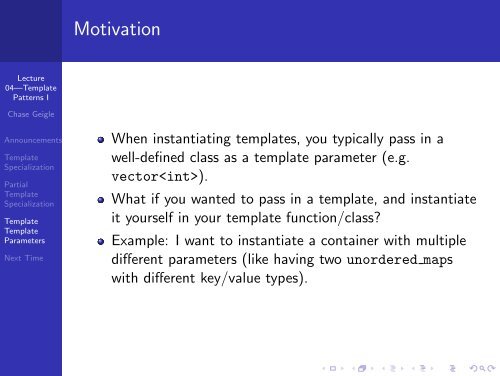here - Chara - University of Illinois at Urbana-Champaign
here - Chara - University of Illinois at Urbana-Champaign
here - Chara - University of Illinois at Urbana-Champaign
You also want an ePaper? Increase the reach of your titles
YUMPU automatically turns print PDFs into web optimized ePapers that Google loves.
Lecture<br />
04—Templ<strong>at</strong>e<br />
P<strong>at</strong>terns I<br />
Chase Geigle<br />
Announcements<br />
Templ<strong>at</strong>e<br />
Specializ<strong>at</strong>ion<br />
Partial<br />
Templ<strong>at</strong>e<br />
Specializ<strong>at</strong>ion<br />
Templ<strong>at</strong>e<br />
Templ<strong>at</strong>e<br />
Parameters<br />
Next Time<br />
Motiv<strong>at</strong>ion<br />
When instanti<strong>at</strong>ing templ<strong>at</strong>es, you typically pass in a<br />
well-defined class as a templ<strong>at</strong>e parameter (e.g.<br />
vector).<br />
Wh<strong>at</strong> if you wanted to pass in a templ<strong>at</strong>e, and instanti<strong>at</strong>e<br />
it yourself in your templ<strong>at</strong>e function/class?<br />
Example: I want to instanti<strong>at</strong>e a container with multiple<br />
different parameters (like having two unordered maps<br />
with different key/value types).


